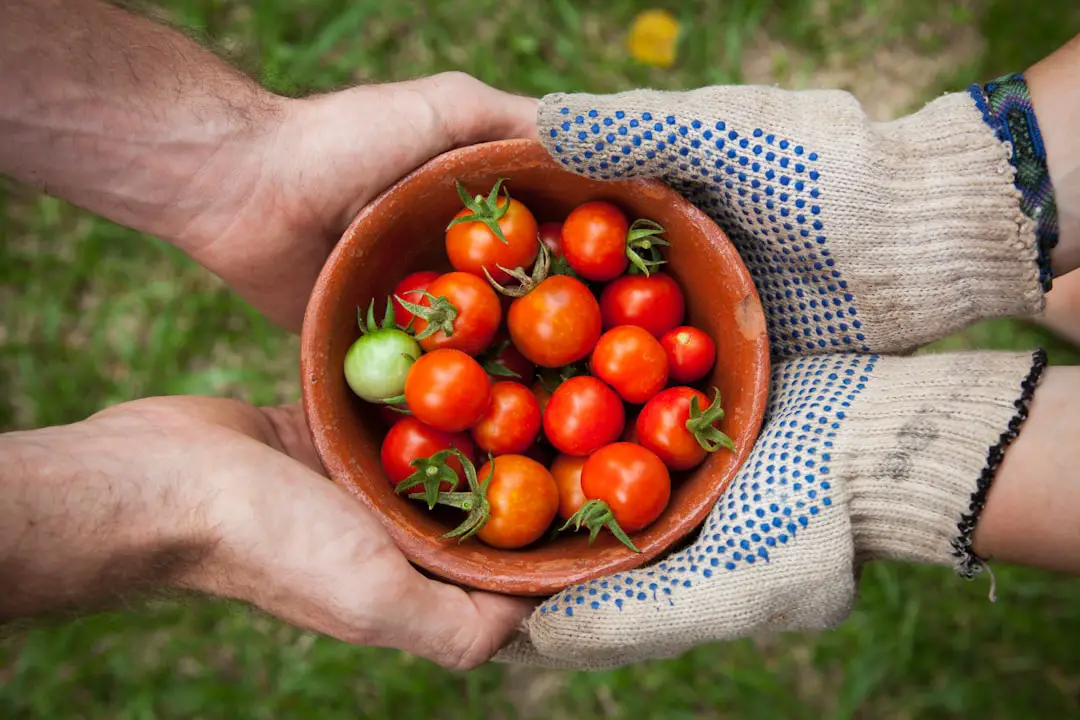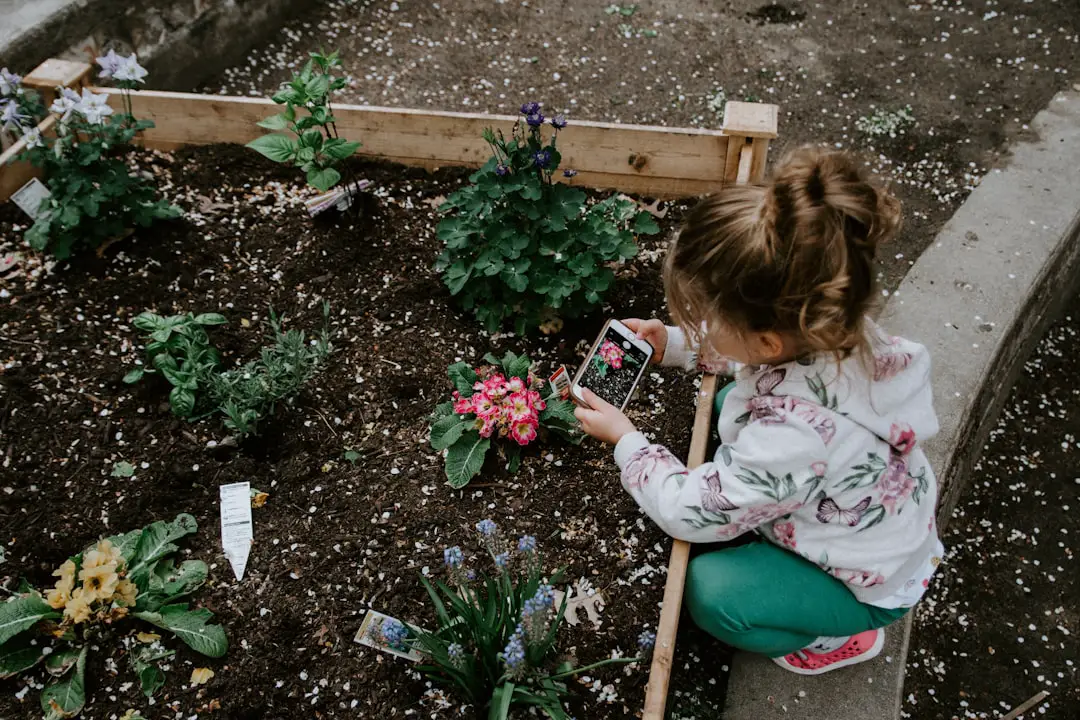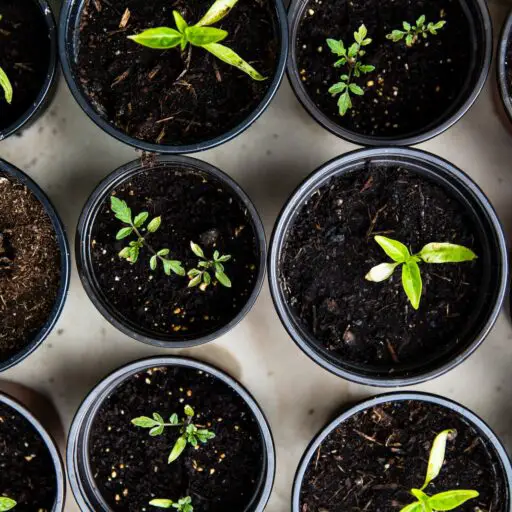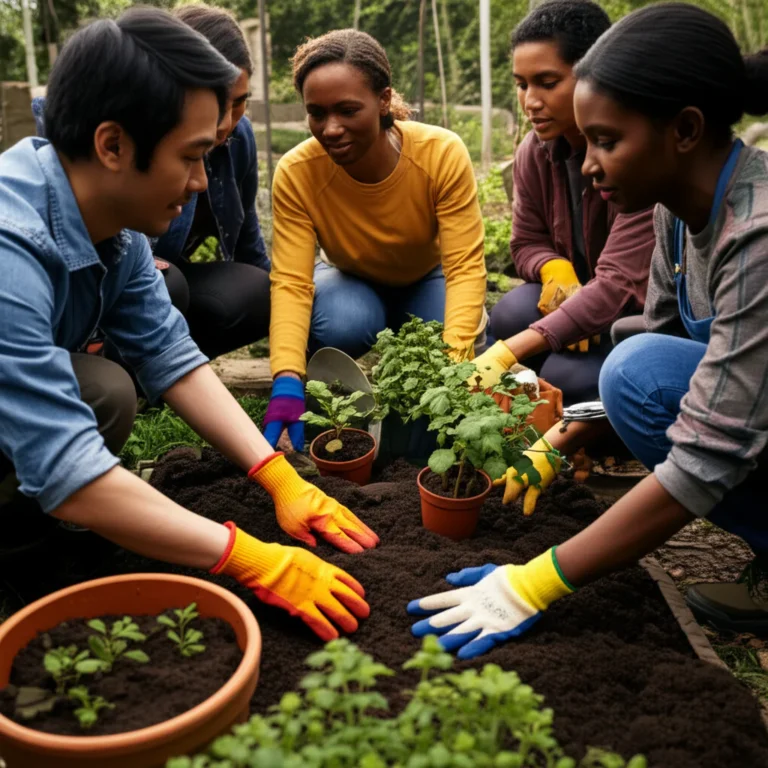Support our educational content for free when you purchase through links on our site. Learn more
Community gardens are more than just patches of green in urban landscapes; they are thriving ecosystems that enrich local communities in countless ways! Did you know that community gardens can reduce food insecurity by up to 90%? That’s right! These vibrant spaces not only provide fresh produce but also foster social connections, enhance mental well-being, and promote environmental sustainability. In this article, we’ll explore 20 remarkable benefits of community gardening that can transform your neighborhood into a healthier, happier place to live.
Imagine stepping into your local community garden, surrounded by the laughter of neighbors, the scent of fresh herbs, and the sight of colorful blooms. Whether you’re a seasoned gardener or just curious about the green thumb lifestyle, you’ll find that community gardens offer something for everyone. So, are you ready to dig into the many ways these gardens can enrich your life and community? Let’s get started!
Key Takeaways
- Nourishing Communities: Community gardens significantly increase access to fresh, affordable produce, especially in food deserts.
- Health Boost: Participants in community gardening consume more fruits and vegetables, leading to improved diets and reduced health risks.
- Social Connections: These gardens foster social interactions, breaking down barriers and building stronger community ties.
- Environmental Benefits: Community gardens enhance urban biodiversity, improve air quality, and promote sustainable gardening practices.
- Economic Impact: Properties near community gardens often see increased values, and local economies benefit from job creation and fresh produce sales.
Ready to start your gardening journey? Check out our recommended gardening tools and supplies:
- Gardening Tools: Shop on Amazon
- Seeds and Plants: Shop on Amazon
- Gardening Books: Shop on Amazon
Dive into the article to learn more about how community gardens can enrich your life and your neighborhood! 🌼
Table of Contents
Quick Tips and Facts
The Rich History and Evolution of Community Gardens
What Exactly Is a Community Garden?
Top 20 Benefits of Community Gardening for Local Communities
Best Types of Crops to Grow in Community Gardens
Public Health Benefits: How Community Gardens Improve Well-Being
Environmental Impact: Greening Our Urban Spaces
Community Engagement: Building Stronger Neighborhoods
Explore More Ways to Promote Positive Community Change Through Gardening
Tips for Starting Your Own Community Garden
Challenges and Solutions in Community Gardening
Success Stories: Inspiring Community Garden Projects
Conclusion
Recommended Links
FAQ
Reference Links
Quick Tips and Facts (#quick-tips-and-facts)
Want to impress your fellow community gardeners with your knowledge? Here are some fascinating tidbits about the wonderful world of community gardening:
- Did you know that there are an estimated 18,000 community gardens blossoming across the United States and Canada? That’s a whole lot of homegrown goodness! [1]
- Community gardens can significantly reduce household food security concerns by up to a whopping 90%! That’s a testament to the power of growing your own food. [3]
- Studies show that community gardeners consume a remarkable 37.5% more fruits and vegetables than their non-gardening counterparts. Talk about a healthy harvest! [3]
- For every dollar invested in a community garden, you can reap about six dollars worth of produce. Now that’s what we call a return on investment! [3]
- Women who participate in community gardening are an impressive 46% less likely to be overweight compared to their neighbors. Gardening: the fun way to stay fit! [3]
The Rich History and Evolution of Community Gardens (#the-rich-history-and-evolution-of-community-gardens)

Community gardens, in their various forms, have been around for centuries, evolving alongside societal needs and values. From ancient communal farming practices to modern urban gardening initiatives, the core principle of shared cultivation has remained a constant.
Early Forms of Community Gardening
- Ancient Agricultural Practices: Many cultures throughout history have engaged in communal farming practices, where land and resources were shared for the benefit of the community.
- Medieval Times: Monasteries often maintained gardens that provided food for both monks and the surrounding community.
- Victory Gardens: During World War I and II, governments encouraged citizens to plant “Victory Gardens” to supplement food rations and boost morale. These gardens fostered a sense of community and self-reliance during times of scarcity.
The Rise of Modern Community Gardens
- Urbanization and Industrialization: The rapid growth of cities in the 19th and 20th centuries led to concerns about food access, particularly for low-income communities. Community gardens emerged as a way to address these concerns and reconnect urban dwellers with nature.
- The Environmental Movement: The growing awareness of environmental issues in the latter half of the 20th century further fueled the community garden movement. Gardens were seen as a way to promote sustainability, reduce pollution, and create green spaces in urban areas.
- Community Development and Social Justice: In recent decades, community gardens have increasingly been recognized for their social and economic benefits. They are seen as valuable tools for community development, promoting social cohesion, improving public health, and empowering marginalized communities.
Today, community gardens continue to flourish as vibrant spaces that bring people together, foster a love for nature, and contribute to a more sustainable and just food system.
Want to learn more about the global impact of community gardens? Check out our article: What is the Global Impact of Community Gardens? 🌎 10 Key Insights 2025
What Exactly Is a Community Garden? (#what-exactly-is-a-community-garden)
At its heart, a community garden is a shared space where people come together to grow food, flowers, and a sense of community. It’s a place where neighbors become friends, green thumbs flourish, and the harvest is always sweeter when shared.
Here’s what defines a community garden:
- Shared Ownership and Management: Community gardens are typically owned or leased by a community organization, local government, or a group of residents. They are managed collaboratively, with members sharing responsibilities for maintenance, decision-making, and harvesting.
- Open to the Public: Most community gardens welcome anyone who wants to participate, regardless of their gardening experience. They often have a mix of individual plots and communal areas where people can work together.
- Focus on Community Building: While growing food is a central aspect, community gardens are also about fostering social connections, promoting a sense of belonging, and creating a welcoming space for all.
Community gardens can take many forms, including:
- Traditional Allotment Gardens: These gardens consist of individual plots rented out to members, who are responsible for their own gardening.
- Collective Gardens: In this model, members work together to cultivate a shared plot, with decisions and harvests made collectively.
- Educational Gardens: These gardens are often located at schools, community centers, or other institutions, and focus on teaching children and adults about gardening, nutrition, and environmental stewardship.
- Therapeutic Gardens: Designed to promote well-being and healing, therapeutic gardens provide a calming and restorative environment for people with disabilities, mental health challenges, or those recovering from illness.
No matter the form they take, community gardens offer a powerful way to connect with nature, build community, and grow a more sustainable and equitable food system.
Top 20 Benefits of Community Gardening for Local Communities (#top-20-benefits-of-community-gardening-for-local-communities)
Community gardens are more than just patches of green—they’re vibrant hubs that nourish not only our bodies but also our communities. Here are 20 ways these green spaces benefit local communities:
- Increased Access to Fresh, Affordable Produce: Community gardens provide a source of fresh, nutritious food for residents, particularly in low-income neighborhoods where access to affordable produce may be limited.
- Improved Nutrition and Health: Studies have shown that community gardeners tend to eat more fruits and vegetables, leading to improved diets and reduced risk of chronic diseases.
- Enhanced Food Security: By supplementing household food budgets and providing a local source of fresh produce, community gardens contribute to greater food security, especially during times of economic hardship.
- Physical Activity and Outdoor Recreation: Gardening is a great way to get exercise, enjoy the outdoors, and reap the physical and mental health benefits of connecting with nature.
- Environmental Sustainability: Community gardens promote sustainable practices such as composting, water conservation, and reduced reliance on chemical fertilizers and pesticides.
- Urban Greening and Beautification: Transforming vacant lots and neglected spaces into thriving gardens enhances the aesthetic appeal of neighborhoods, making them more inviting and livable.
- Increased Property Values: Studies have shown that properties located near community gardens often experience an increase in value, benefiting homeowners and the neighborhood as a whole.
- Reduced Crime Rates: By creating a sense of ownership and community pride, community gardens can contribute to safer neighborhoods and reduced crime rates.
- Social Cohesion and Community Building: Gardens provide a welcoming space for people from all walks of life to connect, socialize, and build relationships, fostering a stronger sense of community.
- Intergenerational Connections: Gardening brings together people of all ages, from young children to seniors, providing opportunities for intergenerational learning, sharing, and support.
- Cultural Preservation and Exchange: Community gardens often reflect the cultural diversity of their neighborhoods, with gardeners sharing traditional foods, gardening practices, and cultural knowledge.
- Educational Opportunities: Gardens serve as living classrooms, offering hands-on learning experiences about gardening, nutrition, environmental science, and sustainability.
- Job Creation and Economic Development: Some community gardens create job opportunities through farmers’ markets, community-supported agriculture (CSA) programs, or by supplying local businesses.
- Empowerment and Community Leadership: Community gardens empower residents to take an active role in improving their neighborhoods, develop leadership skills, and advocate for positive change.
- Increased Civic Engagement: Participation in community gardens can lead to greater civic engagement, with residents becoming more involved in local issues and decision-making processes.
- Improved Mental Health and Well-being: Studies have shown that gardening can have therapeutic benefits, reducing stress, anxiety, and symptoms of depression, and promoting overall well-being.
- Reduced Food Waste: By growing their own food and sharing surplus harvests, community gardeners contribute to reducing food waste and promoting a more sustainable food system.
- Climate Change Mitigation: Community gardens help mitigate climate change by sequestering carbon dioxide from the atmosphere, reducing urban heat island effects, and promoting local food production.
- Increased Biodiversity: By providing habitat for pollinators, birds, and other wildlife, community gardens contribute to urban biodiversity and a healthier ecosystem.
- Enhanced Community Resilience: Community gardens enhance resilience by providing local food sources, fostering social connections, and empowering communities to address challenges collectively.
These numerous benefits highlight the transformative power of community gardens in creating healthier, more sustainable, and vibrant communities for all.
Best Types of Crops to Grow in Community Gardens (#best-types-of-crops-to-grow-in-community-gardens)
Choosing the right crops can make all the difference in the success and enjoyment of your community garden. Here are some factors to consider when selecting crops:
- Climate and Growing Season: Opt for varieties that thrive in your local climate and have a suitable growing season.
- Space Availability: Consider the size of your garden plots and choose crops that can be grown efficiently in the available space.
- Community Preferences: Involve community members in the decision-making process and select crops that align with their dietary preferences and cultural traditions.
- Ease of Care: Choose crops that are relatively easy to grow and maintain, especially for beginner gardeners.
- Pest and Disease Resistance: Select varieties that are known for their resistance to common pests and diseases in your area.
Here are some of the best types of crops for community gardens, categorized by type:
Vegetables:
- Easy to Grow: Lettuce, spinach, radishes, carrots, zucchini, beans, cucumbers
- High Yielding: Tomatoes, peppers, squash, potatoes, onions, garlic
- Unique and Interesting: Eggplants, okra, Swiss chard, kale, herbs
Fruits:
- Small Space Friendly: Strawberries, blueberries, raspberries
- Tree Fruits: Apples, pears, peaches, plums (consider dwarf varieties for smaller spaces)
Herbs:
- Culinary Delights: Basil, parsley, cilantro, oregano, thyme, rosemary
- Medicinal Herbs: Chamomile, lavender, mint, lemon balm
Flowers:
- Pollinator Attractants: Sunflowers, zinnias, cosmos, lavender, bee balm
- Cut Flowers: Dahlias, lilies, gladiolus
Remember to rotate crops annually to prevent soil depletion and reduce pest and disease problems.
Public Health Benefits: How Community Gardens Improve Well-Being (#public-health-benefits-how-community-gardens-improve-well-being)
Community gardens are blooming with public health benefits, nurturing not just plants but also the well-being of individuals and communities. Let’s delve into the ways these green spaces contribute to a healthier society:
1. Increased Fruit and Vegetable Consumption
- Access and Affordability: Community gardens increase access to fresh, affordable produce, particularly in underserved communities designated as “food deserts.”
- Dietary Habits: Studies show that community gardeners tend to consume more fruits and vegetables, leading to healthier diets and reduced risk of chronic diseases. [2]
2. Physical Activity and Reduced Obesity
- Active Lifestyles: Gardening involves physical activity such as digging, planting, weeding, and harvesting, promoting active lifestyles and combating sedentary behaviors.
- Obesity Prevention: Increased physical activity, combined with improved diets, contributes to healthy weight management and reduces the risk of obesity-related health problems.
3. Mental Health Benefits
- Stress Reduction: Studies have shown that spending time in nature, such as community gardens, can reduce stress levels, lower blood pressure, and improve mood. [3]
- Social Interaction and Community Support: Community gardens foster social connections and provide a sense of belonging, which are essential for mental well-being and reducing social isolation.
4. Community Building and Social Cohesion
- Shared Spaces, Shared Goals: Community gardens bring people together from diverse backgrounds, fostering a sense of community and shared purpose.
- Social Capital: These gardens strengthen social ties, build trust among neighbors, and create opportunities for collective action, contributing to a more cohesive and resilient community.
5. Environmental Health Benefits
- Green Spaces and Air Quality: Community gardens increase green spaces in urban areas, improving air quality by absorbing pollutants and releasing oxygen.
- Reduced Pesticide Exposure: By promoting organic gardening practices, community gardens reduce exposure to harmful pesticides, benefiting both human health and the environment.
6. Educational Opportunities for Healthier Lifestyles
- Nutrition Education: Many community gardens offer workshops and classes on gardening, nutrition, and healthy cooking, empowering individuals to make informed choices about their health.
- Intergenerational Learning: Gardens provide a platform for sharing knowledge and skills across generations, promoting healthy habits from a young age.
Community gardens are valuable assets that contribute to a healthier, more equitable, and vibrant society. By promoting healthy eating, physical activity, mental well-being, and social connections, these green spaces play a vital role in improving public health outcomes.
Environmental Impact: Greening Our Urban Spaces (#environmental-impact-greening-our-urban-spaces)
Community gardens are more than just patches of beauty amidst concrete jungles—they’re powerful agents of positive environmental change, transforming urban landscapes and fostering a more sustainable future. Let’s explore their significant environmental impact:
1. Urban Greening and Biodiversity
- Increased Green Spaces: Community gardens transform vacant lots, rooftops, and underutilized spaces into vibrant green oases, increasing the overall green cover in urban areas.
- Habitat Creation: These gardens provide essential habitats for pollinators like bees and butterflies, birds, beneficial insects, and other wildlife, enhancing urban biodiversity and supporting a healthier ecosystem.
2. Improved Air Quality
- Pollution Absorption: Plants in community gardens act as natural air purifiers, absorbing carbon dioxide, ozone, and other pollutants from the air, improving air quality and reducing the urban heat island effect.
- Oxygen Production: Through photosynthesis, plants release oxygen into the atmosphere, contributing to a healthier and more breathable environment.
3. Soil Health and Water Conservation
- Soil Improvement: Community gardens often employ organic gardening practices, such as composting and mulching, which improve soil structure, fertility, and water retention capacity.
- Water Conservation: By improving soil health and using water-wise gardening techniques, community gardens help conserve water, a precious resource in urban environments.
4. Reduced Carbon Footprint
- Local Food Production: Growing food locally in community gardens reduces reliance on industrial agriculture, which is a major contributor to greenhouse gas emissions through transportation, packaging, and intensive farming practices.
- Reduced Food Waste: Community gardens promote the consumption of fresh, locally grown produce, reducing food waste associated with transportation, storage, and spoilage.
5. Environmental Education and Stewardship
- Hands-on Learning: Community gardens serve as living classrooms, providing opportunities for people of all ages to learn about environmental science, sustainability, and the importance of protecting our planet.
- Community Engagement: By engaging residents in environmental stewardship, community gardens foster a sense of responsibility for the environment and inspire action towards a more sustainable future.
Community gardens are essential components of a greener, healthier, and more sustainable urban environment. By promoting biodiversity, improving air and soil quality, conserving water, reducing carbon footprints, and fostering environmental stewardship, these green spaces are making a tangible difference in creating a more livable and resilient future for all.
Community Engagement: Building Stronger Neighborhoods (#community-engagement-building-stronger-neighborhoods)
Community gardens are much more than just places to grow food—they’re fertile ground for cultivating strong social connections, fostering a sense of belonging, and building more resilient and vibrant neighborhoods. Here’s how these green spaces bring people together:
1. Shared Spaces, Shared Experiences
- Breaking Down Barriers: Community gardens provide welcoming and inclusive spaces where people from diverse backgrounds, ages, and walks of life can come together, breaking down social barriers and fostering a sense of community.
- Common Ground: Gardening offers a shared activity and common ground for people to connect, build relationships, and learn from one another, regardless of their background or experience.
2. Collaborative Efforts, Collective Success
- Teamwork and Cooperation: Community gardens thrive on collaboration, with members working together to maintain the space, share resources, and celebrate the fruits of their labor.
- Shared Responsibility: The shared responsibility of caring for the garden fosters a sense of ownership and pride among community members, strengthening their connection to the space and to each other.
3. Social Events and Community Gatherings
- Hubs for Social Interaction: Many community gardens host social events, potlucks, workshops, and celebrations, providing opportunities for neighbors to connect, socialize, and build relationships outside of the garden.
- Intergenerational Connections: These events often bring together people of all ages, fostering intergenerational connections and creating a sense of community that spans generations.
4. Community Empowerment and Leadership
- Taking Ownership: Community gardens empower residents to take an active role in shaping their neighborhoods, providing a platform for community organizing, advocacy, and civic engagement.
- Developing Leadership Skills: The collaborative nature of community gardens provides opportunities for individuals to develop leadership skills, learn new skills, and share their knowledge with others.
5. Increased Safety and Reduced Crime
- Eyes on the Street: Community gardens can contribute to safer neighborhoods by increasing foot traffic, providing “eyes on the street,” and fostering a sense of community watchfulness.
- Reclaiming Public Spaces: By transforming vacant lots and neglected spaces into vibrant community hubs, community gardens can deter crime and create a more welcoming and inviting atmosphere.
Community gardens are powerful tools for building stronger, more connected, and resilient neighborhoods. By fostering social interaction, promoting collaboration, empowering residents, and creating a sense of shared ownership, these green spaces cultivate a sense of community that extends far beyond the garden gates.
Explore More Ways to Promote Positive Community Change Through Gardening (#explore-more-ways-to-promote-positive-community-change-through-gardening)
Inspired by the transformative power of community gardens? There are even more ways to sow the seeds of positive change through gardening! Here are some inspiring avenues to explore:
- School Gardens: Establish gardens at schools to teach children about nutrition, environmental science, and the joys of growing their own food.
- Urban Farms: Create urban farms on vacant lots or rooftops to increase access to fresh produce, create jobs, and revitalize neighborhoods.
- Therapeutic Gardens: Design gardens specifically for therapeutic purposes, providing calming and restorative spaces for individuals with disabilities, mental health challenges, or those recovering from illness.
- Seed Libraries: Establish seed libraries where community members can borrow and share seeds, promoting biodiversity and access to a wider variety of plants.
- Community Composting Programs: Encourage composting in neighborhoods to reduce waste, create nutrient-rich soil amendments, and promote environmental sustainability.
Want to delve deeper into the benefits of community gardens? Explore these resources on our website:
- Benefits of Community Gardens
- Community Garden Events
- Community Garden Policies
- Garden Design Ideas
- Garden Maintenance Tips
By embracing these diverse gardening initiatives, we can cultivate a more just, sustainable, and thriving future for all. Let’s continue to grow together! 🌱
Tips for Starting Your Own Community Garden (#tips-for-starting-your-own-community-garden)
Ready to dig into the rewarding journey of starting a community garden? It’s an endeavor that requires careful planning, community involvement, and a sprinkle of green-thumb enthusiasm. Here’s a step-by-step guide to help you get started:
1. Gather Community Support
- Identify Potential Members: Reach out to neighbors, local organizations, schools, and community centers to gauge interest and gather potential members.
- Host a Community Meeting: Organize a meeting to discuss the idea, gather input, and form a core group of dedicated individuals to spearhead the project.
2. Find a Suitable Location
- Assess Available Spaces: Identify potential locations such as vacant lots, parks, schoolyards, or underutilized land owned by the city or private owners.
- Consider Sunlight, Soil, and Water Access: Ensure the chosen location receives adequate sunlight (at least 6 hours per day), has decent soil quality, and access to a water source.
3. Secure Funding and Resources
- Explore Funding Options: Research grants, crowdfunding campaigns, or partnerships with local businesses or organizations to secure funding for your garden.
- Gather Tools and Materials: Collect donations or purchase essential gardening tools, seeds, soil amendments, and other materials needed to get started.
4. Develop Garden Rules and Guidelines
- Establish Clear Expectations: Create a set of rules and guidelines regarding garden maintenance, plot allocation, water usage, conflict resolution, and other important aspects.
- Ensure Inclusivity and Accessibility: Design the garden to be accessible to people of all abilities and backgrounds, considering factors such as raised beds, pathways, and multilingual signage.
5. Prepare the Garden Site
- Clean Up and Remove Debris: Clear the site of any debris, rocks, or unwanted vegetation.
- Test and Amend the Soil: Conduct a soil test to determine its pH and nutrient levels, and amend the soil accordingly with compost, manure, or other organic matter.
6. Plant with Purpose
- Choose Suitable Crops: Select crops that thrive in your local climate, consider community preferences, and aim for a diversity of fruits, vegetables, herbs, and flowers.
- Practice Sustainable Gardening: Implement organic gardening practices, such as composting, mulching, and natural pest control, to promote environmental sustainability.
7. Maintain and Celebrate Your Garden
- Establish a Watering Schedule: Create a regular watering schedule, especially during dry periods, and consider installing a rainwater harvesting system.
- Organize Work Parties: Host regular work parties to share gardening tasks, foster community spirit, and ensure the garden is well-maintained.
- Celebrate Your Harvest: Organize potlucks, harvest festivals, or other events to celebrate the bounty of your garden and bring the community together.
Starting a community garden is a rewarding journey that brings people together, beautifies neighborhoods, and promotes a healthier and more sustainable way of life. By following these tips and embracing the power of community, you can create a thriving green space that nourishes both body and soul.
Challenges and Solutions in Community Gardening (#challenges-and-solutions-in-community-gardening)
While community gardens offer a plethora of benefits, they also come with their own set of challenges. However, with a proactive approach and a spirit of collaboration, these hurdles can be overcome, leading to even stronger and more resilient gardens. Here are some common challenges and practical solutions:
1. Funding and Resource Constraints
- Challenge: Securing adequate funding for tools, materials, water, and other essential resources can be a constant challenge for community gardens.
- Solutions:
- Explore grant opportunities from local foundations, government agencies, or organizations that support community gardening initiatives.
- Launch crowdfunding campaigns to engage the community and raise funds for specific projects or needs.
- Partner with local businesses or organizations to secure in-kind donations of tools, materials, or expertise.
2. Land Access and Security
- Challenge: Finding and securing suitable land for a community garden, especially in urban areas, can be a significant obstacle.
- Solutions:
- Collaborate with city officials to identify vacant lots, underutilized parks, or other public land that could be used for community gardening.
- Negotiate lease agreements with private landowners who are willing to make their land available for community use.
- Implement security measures such as fencing, signage, and community watch programs to deter theft or vandalism.
3. Water Management
- Challenge: Ensuring adequate and reliable water access for irrigation can be a challenge, especially during dry periods or in areas with water restrictions.
- Solutions:
- Install water-efficient irrigation systems such as drip irrigation or soaker hoses to minimize water waste.
- Collect rainwater in rain barrels or cisterns to supplement irrigation needs.
- Advocate for policies that support water conservation and provide incentives for community gardens.
4. Pest and Disease Control
- Challenge: Pests and diseases can damage crops and reduce yields, posing a challenge for community gardeners.
- Solutions:
- Implement organic pest control methods such as companion planting, beneficial insects, and natural repellents.
- Practice crop rotation to disrupt pest and disease cycles.
- Provide education and resources to gardeners on identifying and managing pests and diseases effectively.
5. Community Engagement and Participation
- Challenge: Maintaining consistent community engagement and participation in garden activities can be challenging, especially as enthusiasm may fluctuate over time.
- Solutions:
- Organize regular work parties, workshops, social events, and celebrations to foster community spirit and keep members engaged.
- Establish clear roles and responsibilities for garden tasks to ensure everyone feels involved and valued.
- Create a welcoming and inclusive atmosphere that encourages participation from people of all backgrounds and skill levels.
6. Succession Planning and Long-Term Sustainability
- Challenge: Ensuring the long-term sustainability of the garden, including leadership transitions and ongoing maintenance, requires careful planning.
- Solutions:
- Develop a succession plan to identify and train future leaders for the garden.
- Establish a system for documenting garden rules, procedures, and historical knowledge.
- Cultivate relationships with local organizations or institutions that can provide ongoing support and resources.
By acknowledging these challenges and implementing creative solutions, community gardens can overcome obstacles and flourish as vibrant spaces that nourish both people and the planet.
Success Stories: Inspiring Community Garden Projects (#success-stories-inspiring-community-garden-projects)
Across the globe, community gardens are blossoming into beacons of hope, transforming neighborhoods and inspiring positive change. Let’s delve into some heartwarming success stories that showcase the transformative power of these green spaces:
1. The Edible Schoolyard Project
- Location: Berkeley, California
- Impact: Founded by renowned chef Alice Waters, the Edible Schoolyard Project integrates organic gardens and kitchen classrooms into school curricula, teaching children about food, farming, and the environment. This groundbreaking initiative has inspired similar programs across the country, transforming schoolyards into vibrant learning labs and fostering a generation of healthy eaters and environmental stewards.
2. Ron Finley’s Gangsta Garden
- Location: South Los Angeles, California
- Impact: Ron Finley, also known as the “Gangsta Gardener,” transformed a neglected strip of land in South Los Angeles into a thriving community garden, challenging food deserts and empowering residents to grow their own food. His inspiring story highlights the transformative power of gardening to revitalize communities, promote food justice, and create a more equitable food system.
3. The High Line Park
- Location: New York City, New York
- Impact: Once a derelict elevated railway line, the High Line has been transformed into a stunning urban park featuring lush gardens, walkways, and public art. This innovative project demonstrates how reclaiming urban spaces for nature can create vibrant public spaces, boost tourism, and enhance the quality of life for residents.
4. The Lufa Farms Rooftop Greenhouses
- Location: Montreal, Canada
- Impact: Lufa Farms has pioneered the concept of commercial rooftop greenhouses, growing fresh, pesticide-free produce in the heart of the city. Their innovative approach reduces transportation costs, minimizes environmental impact, and provides residents with access to locally grown food year-round.
5. The Incredible Edible Network
- Location: Todmorden, England
- Impact: The Incredible Edible Network is a global movement that encourages communities to grow food in public spaces, transforming towns and cities into edible landscapes. Their inspiring work demonstrates how grassroots initiatives can create a more sustainable and resilient food system, foster community spirit, and beautify urban environments.
These success stories highlight the diverse ways community gardens are making a positive impact around the world, from promoting food justice and education to revitalizing urban spaces and fostering community connections. They serve as a testament to the transformative power of gardening to create a more just, sustainable, and beautiful world for all.
Conclusion

In conclusion, community gardens are not just patches of green; they are vibrant ecosystems that nurture not only plants but also relationships, health, and sustainability within local communities. From improving access to fresh produce and enhancing public health to fostering social connections and environmental stewardship, the benefits of community gardening are profound and far-reaching.
Key takeaways include:
- Health Benefits: Community gardens promote healthier eating habits and increase physical activity, contributing to improved overall well-being.
- Social Cohesion: They serve as gathering spaces that foster connections among diverse community members, breaking down barriers and building trust.
- Environmental Impact: Community gardens enhance urban biodiversity, improve air quality, and promote sustainable practices that benefit the environment.
- Economic Opportunities: They can boost local economies by increasing property values, creating jobs, and providing access to fresh food.
So, whether you’re a seasoned gardener or a curious newbie, consider getting involved in or starting a community garden. The rewards are plentiful, and the journey is sure to be enriching!
Recommended Links
👉 Shop gardening essentials:
Explore more about community gardening:
- Community Gardening: A Handbook for Beginners Amazon
- The Edible Garden: How to Have Your Garden and Eat It Too Amazon
FAQ

What are the social benefits of community gardens?
Building Community Connections
Community gardens foster social interactions among neighbors, creating a sense of belonging and community spirit. They serve as gathering spaces where individuals from diverse backgrounds can come together, share experiences, and build friendships. This social cohesion can lead to increased trust, collaboration, and collective action within the community.
Reducing Isolation
For many individuals, especially seniors or those new to an area, community gardens provide a welcoming environment that reduces feelings of isolation. Engaging in gardening activities and events helps build supportive relationships, enhancing overall mental well-being.
Read more about “What are the social benefits of community gardens?”
How do community gardens improve access to fresh, healthy food?
Local Food Production
Community gardens produce fresh fruits, vegetables, and herbs right in the neighborhood, making healthy food more accessible to residents. This is particularly important in food deserts, where access to fresh produce is limited. By growing their own food, community members can enjoy nutritious options without the barriers of transportation or high costs.
Education on Nutrition
Many community gardens offer educational programs that teach participants about nutrition, cooking, and healthy eating habits. This knowledge empowers individuals to make informed choices about their diets, leading to improved health outcomes.
Read more about “Are Community Gardens Free? 🌱 Discover 7 Surprising Insights!”
In what ways do community gardens contribute to environmental sustainability?
Promoting Biodiversity
Community gardens enhance urban biodiversity by providing habitats for pollinators, birds, and beneficial insects. This contributes to a healthier ecosystem and supports local wildlife.
Sustainable Practices
Gardening practices such as composting, organic pest control, and water conservation promote environmental sustainability. Community gardens often serve as models for sustainable agriculture, encouraging participants to adopt eco-friendly practices in their own lives.
How do community gardens foster community engagement and education?
Hands-On Learning
Community gardens provide hands-on learning experiences for individuals of all ages. Participants can learn about gardening techniques, environmental science, and nutrition, fostering a deeper connection to the food they grow and consume.
Leadership Development
Engagement in community gardening often leads to the development of leadership skills. Members can take on roles in organizing events, managing resources, and advocating for community needs, empowering them to become active participants in their neighborhoods.
What is the economic impact of community gardens on local communities?
Increased Property Values
Research indicates that properties located near community gardens often experience increased property values. This can benefit homeowners and contribute to the overall economic vitality of the neighborhood.
Job Creation and Local Business Support
Community gardens can create job opportunities through farmers’ markets, community-supported agriculture (CSA) programs, and local food initiatives. Additionally, they support local businesses by providing fresh produce to restaurants, grocery stores, and markets.
Read more about “10 Urban Gardening Initiatives Transforming Cities in 2025 🌱”
Reference Links
- Benefits of Community Gardens – Tulane University
- Community Gardens – National Center for Biotechnology Information
- 15 Benefits of Community Gardening — Patterson’s Community
- Community Gardening – Community Gardening™
- California Healthy Cities and Communities
By embracing the power of community gardens, we can cultivate a healthier, more connected, and sustainable future for our neighborhoods. Let’s dig in and grow together! 🌱





